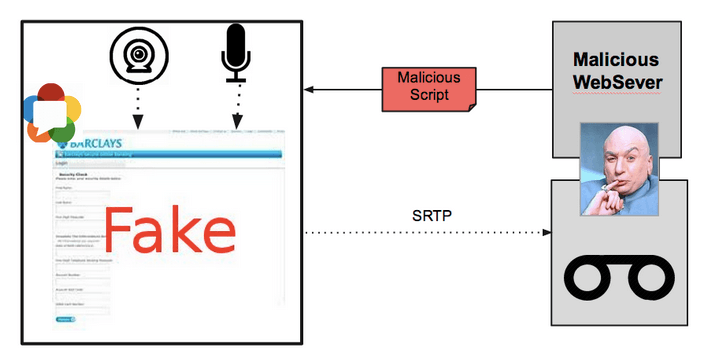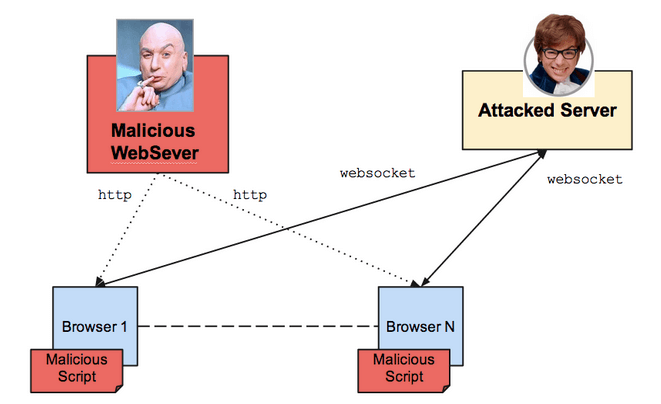WebRTC security concerns
30 June 2014
WebRTC was designed for peer-to-peer communication but It is possible to make WebRTC calls interoperable with other IP or legacy networks, by the use of WebRTC to SIP gateways, that have been released by Session Border Controllers and Media Gateway manufacturers, like the Oracle WSC.
This environment opens up big opportunities for new services for residential (OTT services, vertical applications for e-health, online banking, etc.) and corporate users (BYOD, teleworking, etc.). This new bunch of services and devices could mean an opportunity for intruders and attackers that we should prevent.
As we can see in the figure, that shows a typical WebRTC implementation, we have to introduce a webserver (like the Sippo WebRTC Application Controller) that can be hijacked, a new gateway like theOracle WSC (that could be attacked via DoS attacks or illegally accessed) and, finally a smart endpoint (laptop, smartphone,etc) that can be full of viruses and ad-hoc trojans. In addition, we should take care of the ID of the users involved in the WebRTC session.
 A technique commonly used to make the user aware that his cam is being used, it is to show oneself video stream. The user can be aware that is being recorded and knows what the other side is watching.
Another important thing is to properly notify calls to users and this is not regulated by any standard. It is common to use for both events ringback and ringing tones respectively, simulating the behaviour of any other physical telephone or softphone. An open issue for WebRTC is to notify calls in smartphones when the browser is in background as a push mechanism must be used.
Websockets support cross-domain. This means that you can connect with a server whose domain is different from the domain you downloaded the script from. This gives the necessary flexibility to make websockets useful, but it also could allow some kind of Distributed Denial of Service we must be aware of.
A technique commonly used to make the user aware that his cam is being used, it is to show oneself video stream. The user can be aware that is being recorded and knows what the other side is watching.
Another important thing is to properly notify calls to users and this is not regulated by any standard. It is common to use for both events ringback and ringing tones respectively, simulating the behaviour of any other physical telephone or softphone. An open issue for WebRTC is to notify calls in smartphones when the browser is in background as a push mechanism must be used.
Websockets support cross-domain. This means that you can connect with a server whose domain is different from the domain you downloaded the script from. This gives the necessary flexibility to make websockets useful, but it also could allow some kind of Distributed Denial of Service we must be aware of.
 Imagine a web server controlled by Doctor Evil which hosts a fake web which offers free premium Spotify subscriptions for a year, like the one you see in the figure. After accessing the web a malicious script will be downloaded. As soon as it is executed in the web browser, it will try to connect to the attacked server. This can be managed with an implementation of robust DoS protection policies.
There is another interesting point regarding websockets, since they open a TCP socket through which scripts are able to send any kind of traffic. If this traffic looks exactly the same as HTTP request and response, intermediary elements can potentially interpret the traffic as valid and, for instance, include fake pages in the cache.
In the case of DoS and DDoS attacks, as any other service designed to be available on Internet, WebRTC services must be protected against them. It will receive signalling traffic over TCP so it must implement all the basic protection against attacks. Servers should be able to dynamically blacklisting IPs from where they are receiving attacks.
Access of physical devices and DoS or DDoS are just two examples of potential threads in a WebRTC implementation. Another scenario to take into account is the use of ICE or other NAT traversal techniques, that can also be attacked. Besides this network-level protections, authentication is a another key security element that should be also implemented.
Imagine a web server controlled by Doctor Evil which hosts a fake web which offers free premium Spotify subscriptions for a year, like the one you see in the figure. After accessing the web a malicious script will be downloaded. As soon as it is executed in the web browser, it will try to connect to the attacked server. This can be managed with an implementation of robust DoS protection policies.
There is another interesting point regarding websockets, since they open a TCP socket through which scripts are able to send any kind of traffic. If this traffic looks exactly the same as HTTP request and response, intermediary elements can potentially interpret the traffic as valid and, for instance, include fake pages in the cache.
In the case of DoS and DDoS attacks, as any other service designed to be available on Internet, WebRTC services must be protected against them. It will receive signalling traffic over TCP so it must implement all the basic protection against attacks. Servers should be able to dynamically blacklisting IPs from where they are receiving attacks.
Access of physical devices and DoS or DDoS are just two examples of potential threads in a WebRTC implementation. Another scenario to take into account is the use of ICE or other NAT traversal techniques, that can also be attacked. Besides this network-level protections, authentication is a another key security element that should be also implemented.
- TRADITIONAL VOIP ATTACKS
- AD-HOC ATTACKS IN WEBRTC
 A technique commonly used to make the user aware that his cam is being used, it is to show oneself video stream. The user can be aware that is being recorded and knows what the other side is watching.
Another important thing is to properly notify calls to users and this is not regulated by any standard. It is common to use for both events ringback and ringing tones respectively, simulating the behaviour of any other physical telephone or softphone. An open issue for WebRTC is to notify calls in smartphones when the browser is in background as a push mechanism must be used.
Websockets support cross-domain. This means that you can connect with a server whose domain is different from the domain you downloaded the script from. This gives the necessary flexibility to make websockets useful, but it also could allow some kind of Distributed Denial of Service we must be aware of.
A technique commonly used to make the user aware that his cam is being used, it is to show oneself video stream. The user can be aware that is being recorded and knows what the other side is watching.
Another important thing is to properly notify calls to users and this is not regulated by any standard. It is common to use for both events ringback and ringing tones respectively, simulating the behaviour of any other physical telephone or softphone. An open issue for WebRTC is to notify calls in smartphones when the browser is in background as a push mechanism must be used.
Websockets support cross-domain. This means that you can connect with a server whose domain is different from the domain you downloaded the script from. This gives the necessary flexibility to make websockets useful, but it also could allow some kind of Distributed Denial of Service we must be aware of.
 Imagine a web server controlled by Doctor Evil which hosts a fake web which offers free premium Spotify subscriptions for a year, like the one you see in the figure. After accessing the web a malicious script will be downloaded. As soon as it is executed in the web browser, it will try to connect to the attacked server. This can be managed with an implementation of robust DoS protection policies.
There is another interesting point regarding websockets, since they open a TCP socket through which scripts are able to send any kind of traffic. If this traffic looks exactly the same as HTTP request and response, intermediary elements can potentially interpret the traffic as valid and, for instance, include fake pages in the cache.
In the case of DoS and DDoS attacks, as any other service designed to be available on Internet, WebRTC services must be protected against them. It will receive signalling traffic over TCP so it must implement all the basic protection against attacks. Servers should be able to dynamically blacklisting IPs from where they are receiving attacks.
Access of physical devices and DoS or DDoS are just two examples of potential threads in a WebRTC implementation. Another scenario to take into account is the use of ICE or other NAT traversal techniques, that can also be attacked. Besides this network-level protections, authentication is a another key security element that should be also implemented.
Imagine a web server controlled by Doctor Evil which hosts a fake web which offers free premium Spotify subscriptions for a year, like the one you see in the figure. After accessing the web a malicious script will be downloaded. As soon as it is executed in the web browser, it will try to connect to the attacked server. This can be managed with an implementation of robust DoS protection policies.
There is another interesting point regarding websockets, since they open a TCP socket through which scripts are able to send any kind of traffic. If this traffic looks exactly the same as HTTP request and response, intermediary elements can potentially interpret the traffic as valid and, for instance, include fake pages in the cache.
In the case of DoS and DDoS attacks, as any other service designed to be available on Internet, WebRTC services must be protected against them. It will receive signalling traffic over TCP so it must implement all the basic protection against attacks. Servers should be able to dynamically blacklisting IPs from where they are receiving attacks.
Access of physical devices and DoS or DDoS are just two examples of potential threads in a WebRTC implementation. Another scenario to take into account is the use of ICE or other NAT traversal techniques, that can also be attacked. Besides this network-level protections, authentication is a another key security element that should be also implemented.
- SUMMARY
Quobis announces Sippo version 2 in GA
Quobis®, the leader in WebRTC applications for service providers, today announced a new version of Sippo WebRTC Application Controller and its associated [...]



